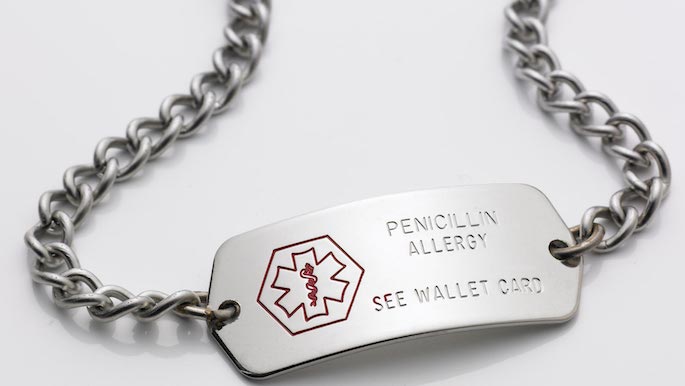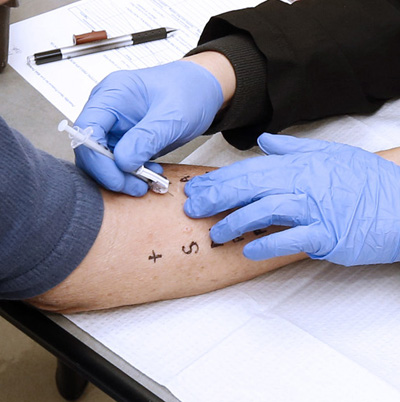A program in the Medical Intensive Care Unit at Vanderbilt University Adult Hospital has successfully removed penicillin allergy labels from more than 45 inpatients at high risk to receive antibiotics, but whose penicillin allergies were low risk.
The plan is to roll out this program first in the Medical ICU, then sequentially move through all inpatient medical units at Vanderbilt University Medical Center. The program is being led by Cosby Stone Jr., MD, MPH, instructor in Medicine, under the mentorship of Elizabeth Phillips, MD, professor of Medicine, and the Learning Healthcare System at VUMC.

The Infectious Disease Society of America, the American Academy of Allergy, Asthma and Immunology and the Centers for Disease Control and Prevention have all recently called attention to the growing problem of penicillin “labeling,” Stone said.
An estimated 10% of the U.S. population carries a penicillin allergy label. Most patients were given this allergy label in childhood; 75% by age 3. Yet when tested today, fewer than 5% of adults are truly allergic. The rest presumably outgrew their allergies or were never allergic to begin with.
The current overuse of alternative, broad-based antibiotics contributes to the development of drug-resistant bacteria including Clostridioides difficile, Methicillin-resistant Staphylococcus aureus (MRSA) and vancomycin-resistant enterococci, which can cause life-threatening infections and can spread to other patients.
The inability to give penicillin to patients labeled as allergic in the hospital results in a higher incidence of drug-resistant infections, a higher chance of surgical site infections and antibiotic treatment failures, longer hospital stays and higher costs, Stone said.
“When you’re in the ICU the likelihood that you’ll need an antibiotic is really high. If you have a penicillin allergy on your chart, that means when you get admitted, we often have to work around it to treat you for infections,” Stone said. “And after many years of ‘work-around-it’ being our standard of care, the evidence emerged that the outcomes from our workaround antibiotics are often worse than if you could just take penicillin.”
Stone said that some of the worst penicillin allergies result in anaphylactic shock or rashes that are as bad as a severe burn, but most of these patients who are currently labeled as allergic had milder reactions including gastrointestinal upset, swelling at the injection site or mild childhood rashes that at the time the medical community thought might be a precursor to a more severe allergy. They also frequently report symptoms that are inconsistent with an allergy, or say they avoid penicillin because a relative had a reaction.
“In the past the medical community hasn’t been sure if these milder reactions or symptoms were a precursor to the really bad outcome (such as anaphylactic shock) or if they were even connected to penicillin at all,” he said. “With that uncertainty hanging over their heads the advice from most doctors on every symptom, from mild to severe, was the same: avoid penicillin,” he said.
“It’s also been shown in the last decade that anaphylaxis-type reactions to penicillin go away at a rate of around 10% per year, so by the time 10 years has gone by, even some of the truly severe allergies are often gone.”
The VUMC study focuses on a group of patients who because of the low severity of their initial reactions were probably unlikely to have been allergic in the first place. They also focus on those who are less likely to be allergic because of the passage of time. This accounts for about 60% of those labeled allergic to penicillin, Stone said.
Patients with more severe reactions — severe skin rashes, organ injuries or anaphylaxis — were not asked to participate in the study, funded by the Agency for Healthcare Research and Quality.
About 75% of patients with low-risk penicillin allergies in the MICU who were asked to take a challenge dose without a preceding skin test agreed to participate. They were given a “baby” dose of 250 mg of amoxicillin, in the penicillin drug family, then observed carefully for an hour. Of the 44 people tested in the MICU so far, none were allergic to penicillin.
“We now know how to pick them. That’s the point of our current study,” Stone said. “When we offer to have a patient take this dose of amoxicillin without a preceding allergy skin test, we are really saying, ‘you can do this safely.’”
Prior to the MICU study, more than 300 patients in the Drug Allergy Clinic at VUMC were tested for penicillin allergy. They were first given a skin test, then if that was negative, were given a small dose of amoxicillin. This led to the validation of a risk questionnaire that identifies which patients are low risk. “We focused on selecting patients who never had positive skin tests or failed oral challenges in our clinic,” Stone said.
Testing patients with low risk for penicillin allergies is now becoming a standard of care in the MICU, Stone said, with physicians and pharmacists giving observed challenge doses once patients are stable, can give a history and are willing to be tested. The process takes about an hour.
As the study is rolled out to additional inpatient units in the adult hospital, pharmacists and physicians in each unit will be trained on when to offer a challenge dose to low-risk patients. Stone said the history-based testing approach is one that any physician or pharmacist will be able to perform as long as the patient can be observed in a medical setting with the ability to treat for anaphylaxis on the rare chance that it might occur. No cases of anaphylaxis have yet been observed in any patients with low-risk histories, either in the MICU or the drug allergy clinic.
“They’ll give a dose of amoxicillin, watch the patient closely for an hour, and take the allergy out of their chart when the patient doesn’t react. Then that patient gets to graduate from being labeled as allergic to penicillin.
“We know based on our data so far that it’s a safe procedure to offer to patients with low-risk histories. Those with higher risk histories can be referred for testing or consultation in our allergy clinics,” he said.
“There’s solid evidence that removing a penicillin allergy is going to be safer for the patient and use less resources than working around it with alternative antibiotics. As we implement this at VUMC, our partnership with the Learning Healthcare System will enable us to gather really good data that a routine procedure to remove low-risk penicillin allergies should be our new standard of care.”















